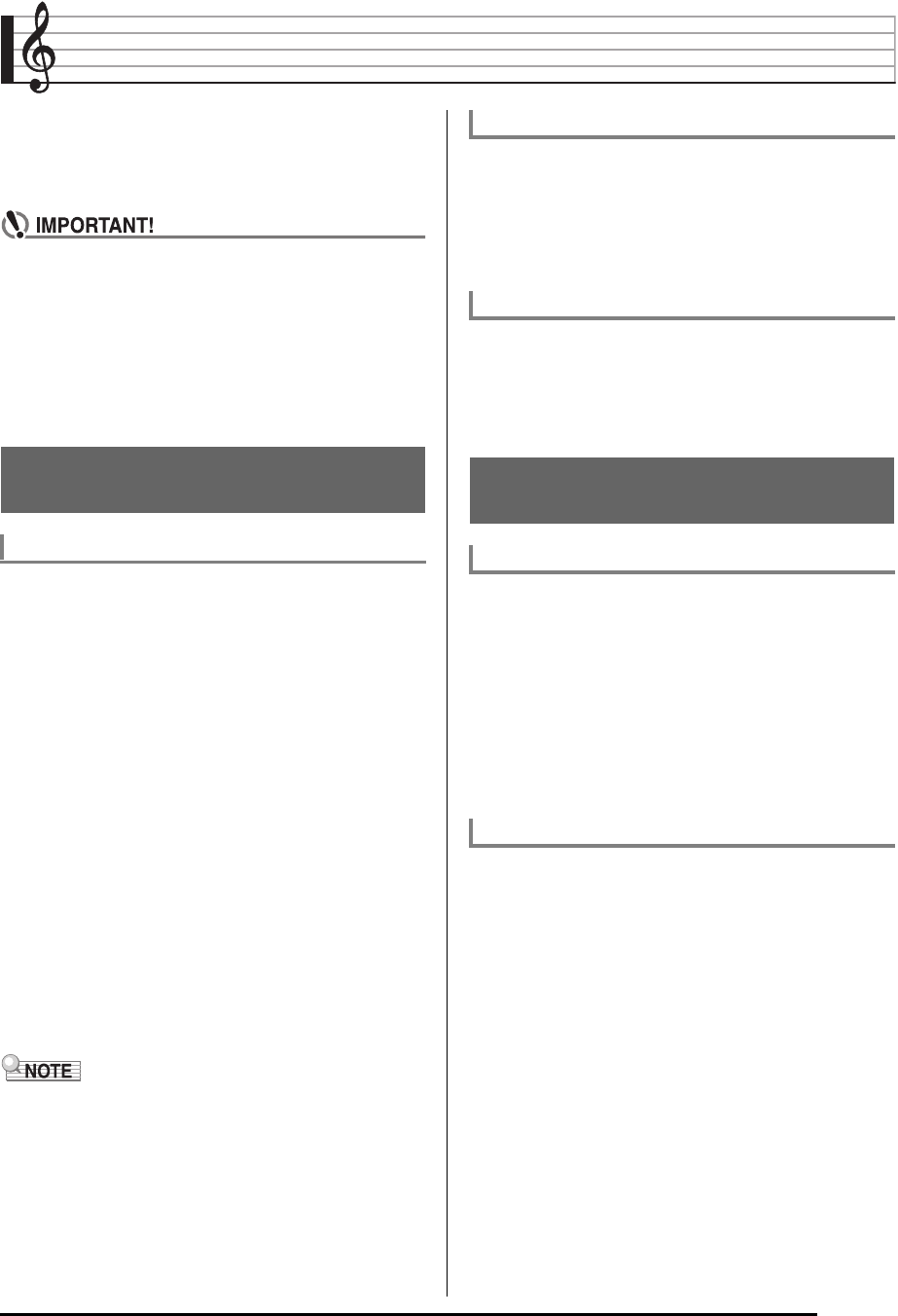
E-121
Recording and Playing Audio
All of the sound output by the Digital Keyboard can be recorded as
audio files on a memory card. The maximum recording time for a
single audio file is approximately 13 minutes. Up to 20 audio files
(actual number of files depends on card capacity) can be recorded
on a single memory card.
• To perform the operations described in this section, you
will need to obtain a commercially available SD memory
card or SDHC memory card with a capacity between 2GB
and 32GB (page E-136).
• The audio recording operation performs memory card
delete and write operations simultaneously. Because of
this, you may not be able to record correctly on certain
types of memory cards. If you experience recording
problems, try changing the file number of the recording or
try using a different memory card.
With audio recording, you can record sound output by the Digital
Keyboard as digital sampling data. Recordings are stored on the
memory card as an audio file.
■ Recording of Keyboard Play and Song Playback
The following can be recorded as-is.
• Rhythm mode keyboard play
You can record a keyboard performance that uses layer and
split, as well as Auto Accompaniment and music preset.
Registration setup recall, effect operations, and mixer
operations are also supported during recording.
• Song sequencer song playback
A song recorded with the song sequencer can be recorded to a
memory card file as it is played back. Most Digital Keyboard
operations that are supported during song playback are also
supported during recording to a memory card file.
■ Recording of Sound Input from an External Device
Sound input from an external device connected to the Digital
Keyboard’s T-6 (MIC IN) jack or T-4 (INST IN) jack is recorded
along with notes played on the Digital Keyboard and sound that is
played back on the Digital Keyboard.
For details about the routes used for output of sound from this
Digital Keyboard’s built-in sound source and output of sound from
an external sound source, see the block diagram under
“Configuration of Effects” (page E-29).
• Input from the Digital Keyboard’s T-5 (AUDIO IN) jack is not
recorded.
This Digital Keyboard supports playback of audio files recorded by
it, as well as audio files that you converted on a computer to a
format supported by the Digital Keyboard.
*
You also can play
along on the keyboard during playback.
* Special application software (Data Manager) is required in
order to convert audio files. For details, see “Storing and
Loading Digital Keyboard Memory Data” (page E-146).
You can use the special application software (Data Manager) to
access audio files on a memory card from your computer. You can
store audio files to a computer local disk and use your computer to
convert audio files to a format that can be played back by the
Digital Keyboard. For details, see “Storing and Loading Digital
Keyboard Memory Data” (page E-146).
The following operations are not possible during audio recording
and playback.
• User rhythm editing (page E-103)
• User tone editing (page E-46)
• User drawbar organ tone editing (page E-52)
• User DSP data editing (page E-33)
• User preset editing (page E-58)
• Song sequencer recording and editing (page E-68)
• Registration setup save (page E-66)
• Card mode operations (page E-137)
Some other operations other than those listed above may also be
disabled.
• Do not touch a memory card loaded in the Digital Keyboard
while recording or playback is in progress. This can cause
operational problems due to electrostatic charge and creates
the risk of making the card unusable. Before touching the
loaded memory card, first stop any ongoing recording or
playback operation.
• Formatting a memory card on the Digital Keyboard will reserve
space for audio recording, which will reduce the total capacity
of the memory card. The amount of the reduction depends on
the maximum number of audio recordings that you specified
when formatting the memory card (page E-137). Using a
computer to open a memory card that has been formatted on
the Digital Keyboard will show this reduced capacity, even if
there are no files on the card. This is normal and does not
indicate malfunction of the memory card.
Audio Recording and Playback
Functions
Audio Recording
Audio Playback
Saving Audio Files on a Computer
Audio Recording and Playback
Precautions
Limitations during Recording and Playback
Memory Card Precautions
CTK7200_e.book 121 ページ 2014年3月7日 金曜日 午後3時4分


















